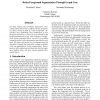Free Online Productivity Tools
i2Speak
i2Symbol
i2OCR
iTex2Img
iWeb2Print
iWeb2Shot
i2Type
iPdf2Split
iPdf2Merge
i2Bopomofo
i2Arabic
i2Style
i2Image
i2PDF
iLatex2Rtf
Sci2ools
CORR
2004
Springer
2004
Springer
Better Foreground Segmentation Through Graph Cuts
For many tracking and surveillance applications, background subtraction provides an effective means of segmenting objects moving in front of a static background. Researchers have traditionally used combinations of morphological operations to remove the noise inherent in the background-subtracted result. Such techniques can effectively isolate foreground objects, but tend to lose fidelity around the borders of the segmentation, especially for noisy input. This paper explores the use of a minimum graph cut algorithm to segment the foreground, resulting in qualitatively and quantitiatively cleaner segmentations. Experiments on both artificial and real data show that the graphbased method reduces the error around segmented foreground objects.
| Added | 17 Dec 2010 |
| Updated | 17 Dec 2010 |
| Type | Journal |
| Year | 2004 |
| Where | CORR |
| Authors | Nicholas R. Howe, Alexandra Deschamps |
Comments (0)

